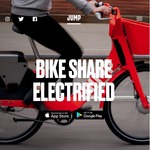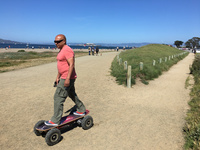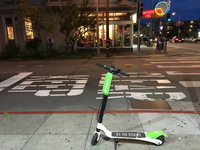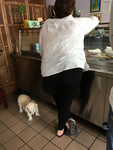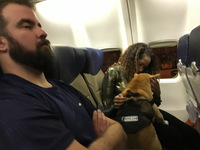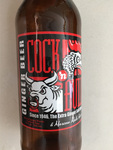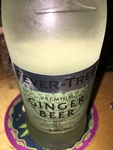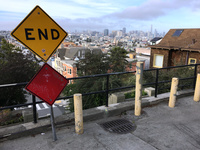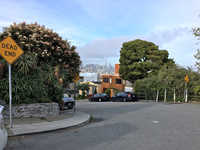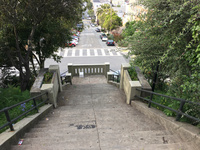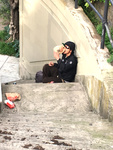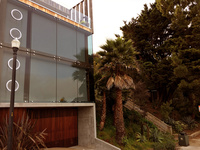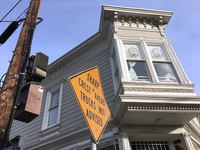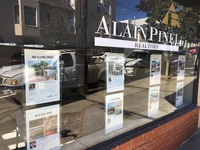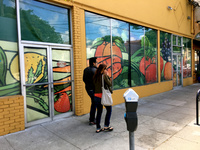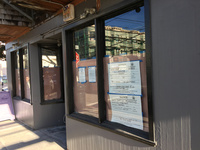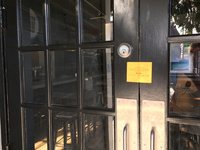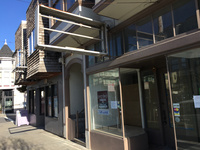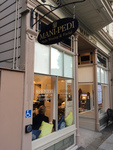 |
| Angelika/Mike Schilli |
|
|
Michael Here in the city and further south in Silicon Valley, not only is the number of Tesla drivers steadily increasing, but more and more muscle-enhancing electric vehicles for short distances are now visibly zipping through the streets, mostly driven by so-called Millennials, or Internet lemmings, as I like to call them.
In Rundbrief 08/2017 I have previously reported on the city bike program "Ford GoBike," which rents out traditional pedal bikes that must be returned to one of the many docking stations in the city after half an hour. The next step was so-called Jump Bikes which you can simply leave anywhere after use, as they automatically report back to the central system and transmit their location via a GPS receiver, so the next customer can book them right away.
Another advantage of the Jump-Bikes: They are equipped with an electric motor that provides powerful assistance while pedaling, allowing the rider to effortlessly zoom up the hills of San Francisco and feel like Superman. But be careful: The bikes accelerate so quickly at green lights that there have reportedly been several accidents because drivers, as is common in San Francisco, tried to quickly run through the intersection on a very late red light.
Recently, Ford GoBike, with whom I purchased an annual membership last September, has also started offering so-called "Plus" bikes, whose electric motor provides powerful assistance while pedaling. While I usually had to shift into first gear and pedal hard on the last stretch up to our apartment on Chattanooga Street with an 8% incline to avoid coming to a complete stop, with the eBike, I zoomed up at lightning speed, as you can see in my
| Video: video |
. I've also tried going up the very steep Hill St in our neighborhood, but the eBike gave up after 50 feet, seems to me like the motor isn't designed for such inclines.
The latest trend is electric scooters that can go up to 20 mph, with which young people sometimes speed along the city's sidewalks.
The New York Times had an article recently on Travis VanderZanden, founder of the rental scooter company "Bird" in Los Angeles, who similar to rideshare companies like Uber or Lyft operated under the motto "execute first, get permssion later". It distributed their scooters all over the sidewalks in San Francisco, to be rented happily by millennials on their phones.
The union bosses and top bureaucratic bigwigs of the "San Francisco Public Works" department confiscated dozens of scooters parked all over the sidewalks. Interestingly, the same department seems to be in a deep office slumber while tent cities are forming on the sidewalks, where drug addicts hoard their stolen bicycles, openly inject heroin, and then, to the delight of the residents, simply discard the needles (Rundbrief 02/2016). Taking away scooters from a wealthy company is just less controversial.
With electric skateboards (Rundbrief 10/2016), opinions are divided. Their owners praise the driving pleasure in the highest terms, but car drivers are annoyed by the additional traffic on the bike lanes, and long-time skateboarders despise the young, wealthy speedsters as lazy and conceited.
As always, when something new comes along, the factions of NIMBYs and the bold trendsetters are now clashing in San Francisco. NIMBY stands for "Not in My Backyard" and refers to the long-time residents who would prefer nothing to change, to keep everything as it was in 1985, and wish the newcomers to hell. The newcomers want to build more ugly residential towers and squeeze more people into the already bursting-at-the-seams infrastructure. In the above-cited New York Times article, an old woman even suspects that the newcomers want to run over the "old farts" with their scooters on the sidewalk to get their rent-controlled apartments. Will this tug-of-war ever end?
Angelika We don't fly very often, but whenever we do, we notice that it has become quite common for passengers to bring their dogs onto the plane. And these are not always small dogs or dogs traveling in a pet carrier. No, the dogs walk into the plane on a leash and then sit on their owner's lap. Flying has already become a pure ordeal because the seats are too small and cramped, and everyone thinks they need to bring half their household onto the plane since all airlines are now charging fees for checked luggage.
I'm always quite annoyed when I board the plane. The idea that I might now also have a dog sitting next to me, slobbering everywhere, makes flying even more unpleasant for me. Well, I'm not exactly a dog fan, but dog lovers don't need to send me angry emails. I have nothing against people who own a dog, as long as they don't exploit the system and let their four-legged friend fly on their lap. By the way, I'm not the only one who gets upset about this bad habit, and for airlines, the issue is becoming more and more of a problem because some dogs go crazy in the unusual situation, poop in the aisle, bark nonstop, or even bite a seat neighbor.
How do dog owners manage to let their Fido fly for free? They simply declare it an "Emotional Support Dog," essentially a supposed therapy dog that provides emotional support to the owner. This should not be confused with a properly trained service dog, which, for example, helps blind people in their daily lives or warns its owner of epileptic seizures. Service dogs are trained to perform specific tasks for their owners that they cannot carry out due to a disability. These dogs cost a lot of money (on average $20,000) due to the rigorous training. Since these types of dogs are vital for their owners, they are allowed to go anywhere, even places where dogs are normally not permitted. In California, for instance, dogs are not allowed inside restaurants or stores where food is sold.
The American Disabilities Act (ADA) ensures that people with disabilities do not have to provide detailed proof that their dog is a service dog. Only two questions are allowed to determine if the dog truly serves this function: "Is the animal required because of a disability? What tasks has the animal been trained to perform?" Given that lawsuits are a common threat in America, I can understand why those responsible might prefer not to inquire too deeply in case of doubt.
The "Emotional Support Dog," on the other hand, is not specially trained but has a calming effect on its owner. If you search for "Emotional Support Dog" on Google, a multitude of providers will come up, where you can register any random dog with a mouse click and at the same time receive a letter from a therapist confirming that the dog is important for their mental health. Also, Amazon sells vests for service animals which identify the dog as an alleged service dog, which can be easily ordered by the dog enthusiast.
Unfortunately, it is now indeed the case that airlines, due to the "Air Carrier Access Act," must allow these "Emotional Support Dogs" on planes alongside legitimate service dogs. No one anticipated that selfish dog owners would ruthlessly exploit this loophole. For people who genuinely need a service dog, this leads to many problems, as no one can distinguish a real service dog from a falsely designated "Emotional Support Dog." Therefore, those affected have long been calling for this loophole to be closed.
On United Airlines and Delta Airlines flights, stricter regulations for dogs flying in the passenger cabin have been in effect since March 1st of this year. According to Delta Airlines, the number of dogs designated as service dogs or "emotional support dogs" on their flights has increased by 150% since 2015, and complaints about animals on board have also risen. Passenger complaints about dogs have surged by 84%. According to the new rules, dog owner must submit a health certificate 48 hours before departure, along with a letter proving why the dog is needed as emotional support. The health certificate should list the dog's vaccinations and include a certificate ensuring that the dog will behave on the plane. I am curious to see how this will be circumvented again.
By the way, passengers are not only trying to pass off their dogs as emotional support animals, but they also bring all sorts of other creatures like snakes, parrots, or pigs. Not to mention the woman who tried to board a United flight with her peacock, which was denied. We also constantly see dogs in supermarkets that are certainly not service dogs; the owners usually justify it by saying that dogs tied up outside the store are often stolen (8). Restaurants are usually more stringent and only allow dogs at outdoor tables (where it is legal), because the health inspector would quickly revoke their license if a dog were found inside.
Angelika It's been over ten years since we were in Santa Fe in the state of New Mexico (Rundbrief 10/2006). And since we really enjoyed it there back then, we decided to spend New Year's Eve in the desert again. Apple closes between Christmas and New Year, and I now have more vacation days than Michael, so I can easily take a few days off. We flew out on December 25th. Now, December 25th here is not only the first day of Christmas but also Christmas Eve, because in the early morning, Americans open presents with their families. Due to this circumstance, we managed to get a super cheap flight to Albuquerque in the morning, because at that time everyone is still sitting under the Christmas tree. However, even in capitalist America, everything is closed on December 25th.
In wise foresight, I had booked us a hotel at our flight destination, Albuquerque, whose hotel restaurant was also open on December 25th. And indeed, everything else was closed, and the downtown area was almost deserted. Only a Japanese restaurant was still open, but it was so overcrowded that we couldn't get in. Albuquerque is somewhat considered the stepchild of New Mexico, overshadowed by Santa Fe, and certainly doesn't have as much to offer, but we spent a pleasant evening there.
Santa Fe is about an hour's drive from Albuquerque, beautifully situated at an altitude of 2,194 meters, and although Santa Fe has only about 84,000 inhabitants, it offers numerous museums and 240 galleries. The climate is extremely dry, and in winter it is sunny but cold. My sinuses, spoiled by the moist San Francisco climate, immediately complained about the dryness, but the brochure from our vacation rental assured us that one gets used to the dryness and altitude. In any case, we used up tons of moisterizing hand balm.
Santa Fe and the state of New Mexico fascinate me because here, Native American culture blends with Spanish (through the Spanish conquerors) and Mexican traditions, as well as a deep connection to nature, spirituality, and Catholicism. New Mexico also has the highest percentage of Latinos (from South America) and Hispanics (from Spain), as well as the second-largest percentage of Native Americans compared to other states. Like San Francisco, Santa Fe is different from the rest of America. It's no wonder that the desert landscape, with its clear air, blue sky, and rock formations that change color in the sunlight, has always attracted artists. While hiking, I repeatedly noticed the abundand silence.
Even when I visited the USA for the first time many years ago, it angered me that Native Americans are not allowed to sell their own jewelry everywhere. Gift shops in various tourist hotspots often do not sell authentic jewelry or take a large portion of the profits. However, on the marketplace in Santa Fe under the arcades of the "Palace of the Governors," you can be sure that the jewelry, woven, and painted goods are authentic. For over 60 years, Native American artists have been selling their artworks here. Only those who belong to a Native American tribe and create their own goods are allowed to spread out a blanket and sell their jewelry here. The art market takes place almost every day, and there are a total of 69 spots. It was, of course, clear that I had to buy something there. I purchased a ring from Marvin Slim.
Forty miles from Santa Fe lies the small town of Chimayo, with a population of 3,000. For Catholics, it is a pilgrimage site similar to Lourdes. The earth here is said to have healing properties, and every year tens of thousands of believers make the pilgrimage to the church built in Spanish colonial style in 1816 in the mountains. They come to scoop the earth from the church ground into containers they bring with them.
The fine earth comes from a hole in a small room of the church. We were not allowed to take photos there, and we also left the earth in the church, but several visitors filled small plastic bags with it. By the way, the earth has to be replenished regularly, and church employees supposedly collect it every day from the surrounding Sangre de Cristo Mountains. Some believers are said to eat or drink the earth to internalize its healing power, although it is said to be sufficient to rub the corresponding body parts with the earth while a prayer is spoken. The old church is beautiful, with thick adobe walls, wooden beams, and folklore-like altar paintings.
The whole atmosphere, however, was very touristy and commercialized for our taste. For example, in a side room, there were hundreds of crutches hanging, supposedly left behind by healed visitors. Although I don't believe in miraculous healings, I did study psychology for several semesters, and we thoroughly investigated the phenomenon of the placebo effect. Nevertheless, I am fascinated by such places and the people who leave no stone unturned for a glimmer of hope.
Michael Today's youth hardly drinks beer anymore. Beverage manufacturers have adapted and now offer all sorts of stimulating energy drinks without sugar. I might still occasionally drink the Indian tea Yerba Mate, but that's about it. I can't fathom how anyone can drink Gatorade or Red Bull, except maybe in the last miles of a marathon just before a complete physical breakdown. I feel similarly about root beer, which doesn't taste like beer at all but rather like liquid Bazooka bubble gum, and the recently appearing "Birch Beer" in hipster supermarkets is just the same junk.
However, I must say that the also trendy ginger beer actually tastes good. It quenches thirst like lemonade but has a very intense ginger flavor that lingers for a while. One of the best ginger beers I've tried comes from Australia, called "Bundaberg," and is supposedly based on an ancient family recipe. As a thirst-quencher, the carbonation lightly burns in the throat, followed by a ginger kick similar to that of ouzo schnapps. It packs about 100 calories per 0.33l bottle, making it not quite as filling as a 0.33l bottle of real branded beer.
Bundaberg is available on the shelves of regular supermarkets in Hawaii. Here in the Bay Area, I've seen it at World Market, even as bulk priced 10-pack. Recently, in Los Angeles, I noticed another ginger beer brand called "Cock Bull," which I also enjoyed. It has an even spicier finish and briefly burns as if there were hot chili peppers in the bottle, but the initial impression quickly dissolves into a pleasant ginger flavor. Highly recommended.
Our mega supermarket Costco has recently started selling a ginger beer from the brand "Fever Tree," and I have to say, this drink really packs a punch; it's so spicy compared to the other ginger beers we tested this time. It burns in the throat, and in direct comparison, the other brands taste like downright bland water. Definitely not for beginners, and the twelve-pack costs $14.99 at Costco, which apparently only has the drink in stock on a trial basis. Grab it while supplies last!
Michael San Francisco is a magnet for tourists, and offers plenty of attractions for visitors following the well-trodden paths of commercial tour operators. That's why almost no one thinks to explore the slightly hidden gems. Recently, we went to eat lunch in the Castro district and afterward were so stuffed that we thought a bit of physical activity wouldn't hurt. So, instead of walking straight home, we took the steep route and trudged up the steep "Liberty Hill".
You usually can only get there by car, because even for a mountain bike the streets are too steep, and due to the rugged terrain, every other dead-end literally leads to nowhere, often with a beautiful wide view of the city at the end. However, there is almost no traffic up there, as hardly anyone wants to subject their car to roads with up to a 40% incline when you can make faster progress down below in the flat area.
Often, between two sections of a street separated by a steep wall, there are public concrete stairs open for public use, even if they often look private and no one is around. Reclusive people live here, such as the eccentric Netscape dot-com millionaire Frederick Roeber, who, you might remember, raised a swastika flag on his medieval-castle-like house after the Trump election, causing an uproar among his neighbors (Rundbrief 12/2016).
Due to the high altitude, hardly any homeless people are found in these neighborhoods, and to my knowledge, none have set up their tents on the sidewalks. Therefore, the homeless mainly plague the flat areas of San Francisco, like the Mission or South of Market. However, professional criminals have discovered that they can sometimes break into the expensive houses on Liberty Hill at night without being disturbed, as the police rarely show up in this area. On neighborhood forums on the internet, one often reads about nighttime break-ins, which, according to published surveillance videos, are often committed by prowling Prius drivers.
The houses vary greatly between "old (money) aristocracy" and "newly rich internet whiz," and some old ramshackle huts are marked with warning signs indicating they are slated for demolition, likely to be replaced soon by more modern "iPods," as a NIMBY recently called the increasingly common three-story apartment buildings hastily thrown up by real estate speculators. The streets are surprisingly clean, the cypress trees in front of the houses neatly trimmed; it's clear that the residents take care of their homes and keep them in top condition. For some properties, it might be difficult to bring larger vehicles like a moving truck up to the front, as these often get stuck at the transitions from flat to steep and vice versa, and yellow warning signs warn against driving heavy vehicles here. Also, carrying crates of drinks on foot is out of the question here, but Americans don't do that anyway.
Michael On our formerly so "Prenzlauer Berg"-like street, 24th Street in Noe Valley, more and more restaurants and shops are closing down and seemingly being replaced by two to three foolproof business models: nail salons and real estate agencies. Bank branches also seem to be doing well, but this monoculture is increasingly annoying the residents, who would prefer to see small fashion boutiques or old-fashioned hardware stores in the neighborhood. By the way, there are rumors that nail salons are good for money laundering, although nothing has been reported to that effect yet. In any case, I now like to call our neighborhood Noe Valley "Nail Valley".
Some store fronts remain shut for months after closing before a daring investor takes on a new project. I don't know how that adds up, but the record holder for the longest-standing vacant store on 24th Street is the Real Food grocery store, which was closed in 2003 and has not reopened since. For almost 15 years now, residents of Noe Valley have been looking incredulously at the empty storefront, for which the landlord could have easily collected $20,000 a month. Simply throwing 3.6 million dollars out the window like that is the height of stupidity.
What I've also noticesd is that newly established restaurant owners often seem to make mistakes in their cost calculations, because, and this applies nationwide in the USA, 59% give up within the first three years. Many complain about the narrow profit margins, which, to be honest, I can't quite understand given the exorbitant prices: A dinner for two at one of the restaurants on our street easily costs $100, and if it's at an exclusive high-end Japanese restaurant, more like $200.
Nevertheless, the restaurants here always fail in the same way: First, they cut back on staff, and one day you find yourself sitting in your regular spot, rubbing your eyes in disbelief because there's only one server responsible for the entire restaurant, and it takes forever for them to even come over to take your drink order. Our favorite place, "Savor," even switched to self-service last year, and guests had to pay for their food at the counter first, take a number to their table, and then a temporary worker would eventually bring the food over.
Not only did we refuse to eat there after this change, but apparently so did other people in the neighborhood, because after six months we found a flyer in the mailbox announcing that "table service" at "Savor" would be reinstated. However, it turned out that the place no longer served its famous crepes on weekdays, only on weekends. Was the preparation of the pancakes the responsibility of a highly paid specialist chef that the business couldn't afford on weekdays? I doubt it, but after a few months, a second flyer arrived, stating that crepes would now be available on weekdays as well. You scratch your head and wonder what kind of businessman makes such crazy decisions.
Meanwhile, both the restaurant "Hamlet" and the bar "Caskhouse" have closed down. Both were run by an experienced hotelier, and both were expensive and packed every evening. Then the bar started opening only on odd weekdays, and the staff at Hamlet was reduced, which led to a decline in customers. Somehow, something went wrong. How can a server, who costs maybe $30 per hour including overhead, and serves, let's say, five tables per hour, each generating $100, even be a factor in the calculation? But don't worry, I will never open a restaurant.
It's sad but true that business models that don't generate much revenue have no chance in an extremely expensive neighborhood like Noe Valley, and so it doesn't surprise me that one of our two dry cleaners has now closed or that the general store "Tuggey's" for hardware supplies, where I could always quickly buy missing screws or gaskets if I was repairing something, has also shut down. Unfortunately, I now have to go to the suburban Home Depot for that. The hardware store "Cliff's Variety" in the neighboring district "Castro" is still running, but it also sells children's toys and very tasteful knick-knacks for furnishing intellectuals' apartments. Angelika shops there regularly.
The number of pet grooming services is also steadily increasing in Noe Valley. Recently, however, a petition circulated after a chain from Los Angeles wanted to open a new pet grooming shop on 24th Street, and the neighbors were outraged because, firstly, there were already two pet groomers, and secondly, local pet grooming mom-and-pop shops are generally preferred over chains. Well, if it makes them happy, it's fine by me.
Greetings from our sometime foolish city:
Angelika and Michael



